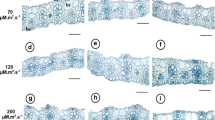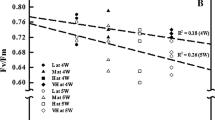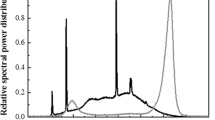Abstract
Attempts of clonal propagation of sugar maple through conventional and micropropagation techniques have been largely unsuccessful and the basis for this longstanding problem has remained unknown. Typical symptoms of stress in in vitro cultures of sugar maple and its intrinsic tolerance to highly shaded growing conditions indicated that optimization of light intensity might overcome its recalcitrance. To test this hypothesis we evaluated the growth, morphology, chlorophyll content and various chlorophyll fluorescence parameters of in vitro plantlets cultured under three intensities (4, 16 and 40 µmol m−2 s−1) using two spectra of light (red-blue and full spectrum white). Higher light intensities increased fresh and dry mass, but had no significant effect on the number of nodes or plant height. Anthocyanin accumulation in tissues, reduction in chlorophyll content, and significantly increased physiological stress quantified by chlorophyll fluorescence parameters, indicated increasing levels of light induced damage to the tissues with increasing light intensities. The critical factor limiting sugar maple’s response to in vitro propagation was light intensity and the levels commonly used for in vitro propagation are not suitable for sugar maple. The current study demonstrates the unique low light requirement, between 4 and 16 µmol m−2 s−1, of this species to overcome the recalcitrance to in vitro propagation. Spectral differences in quality of light and its effect on in vitro growth and stress in cultures are also discussed. In general light induced stress symptoms begin to appear at lower intensities with RB spectrum as compared to the full spectrum lights. While this study is limited to maples, requirement of specific light intensity is likely the cause of recalcitrance in other woody species with similar ecological roles.





Similar content being viewed by others
References
Akhtar TA, Lees HA, Lampi MA, Enstone daryl, Brain RA, Greenberg BM (2010) Photosynthetic redox imbalance influences flavonoid biosynthesis in Lemna gibba. Plant Cell Environ 33:1205–1219
Aro EM, Virgin I, Andersson B (1993) Photoinhibition of Photosystem II. Inactivation, protein damage and turnover. Biochim Biophys Acta 1143:113–134
Baker FS (1949) A revised tolerance table. J For 47:179–181
Barber J, Andersson B (1992) Too much of a good thing: light can be bad for photosynthesis. Trends Biochem Sci 17:61–66
Beaudet M, Messier C (1998) Growth and morphological responses of yellow birch, sugar maple, and beech seedlings growing under a natural light gradient. Can J For Res 28:1007–1015
Bowley S (2015) A hitchhiker’s guide to statistics in plant biology: generalized linear mixed model edition. Plants et al. Inc, Kincardine
Brassard N, Richer C, Tousignanat D, Rioux JA (2003) Multiplication vegetative de l’Acer saccharum: contribution a la micropropagation. Can J For Res 33:682–690
Chen C, Li H, Zhang D, Li P, Ma F (2013) The role of anthocyanin in photoprotection and its relationship with the xanthophyll cycle and the antioxidant system in apple peel depends on the light conditions. Physiol Plant 149:354–366
Connolly DA, Preece JE, Sambeek JW Van (1998) Micropropagation of adult red maple and sugar maple. In: 95th Annual International Conference of the American Society for Horticultural Science. American society for horticultural science, Charlotte, pp 477–478
Das PK, Geul B, Choi S-B, Yoo S-D, Park Y-I (2011) Photosynthesis-dependent anthocyanin pigmentation in Arabidopsis. Plant Signal Behav 6:23–25
Driver JA, Kuniyuki AH (1984) In vitro propagation of Paradox walnut rootstock. HortScience 19(4):507–550
Gabriel WJ, Marvin JW, Taylor FH (1961) Rooting greenwood cuttings of sugar maple, effect of clone and medium. Northeastern Forest Experiment Station, Upper Darby
Genty B, Briantais J-M, Baker NR (1989) The relationship between the quantum yield of photosynthetic electron transport and quenching of chlorophyll fluorescence. Biochim Biophys Acta 990:87–92. doi:10.1016/S0304-4165(89)80016-9
Gitelson AA, Buschmann C, Lichtenthaler HK (1999) The chlorophyll fluorescence ratio F735/F700 as an accurate measure of the chlorophyll content in plants. Remote Sens Environ 69:296–302
Godman RM, Yawney HW, Tubbs CH (1990) Acer saccharum Marsh. Sugar maple. In: Burns RM, Honkala BH (eds) Silvics of North America, vol 2. United States Department of Agriculture, Forest Service, Hardwoods, pp 78–91
Graignic N, Tremblay F, Bergeron Y (2013) Development of polymorphic nuclear microsatellite markers in sugar maple (Acer saccharum Marsh.) using cross-species transfer and SSR-enriched shotgun pyrosequencing. Conserv Genet Resour 5:845–848
Hanus D, Rohr R (1984) Micropropagation de I’erable par bouturage in vitro de germination de trois especes. Can J Bot 63:277–280
Henry PH, Preece JE (1997) Production of rooting of shoots generated from dormant stem sections of maple species. HortScience 32:1274–1275
Hinckley TM, Aslin RG, Aubuchon RR, Metcalf CL, Roberts JE (1978) Leaf conductance and photosynthesis in four species of the oak-hickory forest type. For Sci 24:73–84
Hoch WA, Singsaas EL, McCown BH (2003) Resorption protection. Anthocyanins facilitate nutrient recovery in autumn by shielding leaves from potentially damaging light levels. Plant Physiol 133:1296–1305
Horton P, Ruban AV (1992) Regulation of Photosystem II. Photosynth Res 34:375–385
Hughes W (1981) In vitro ecology: exogenous factors affecting growth and morphogenesis in plant culture systems. Environ Exp Bot 21:281–288
Inada K (1976) Action spectra for photosynthesis in higher plants. Plant Cell Physiol 17:355–365
Janerette CA (1978) An in vitro study of seed dormancy in sugar maple. For Sci 24:43–49
Junker LV, Ensminger I (2016) Relationship between leaf optical properties, chlorophyll fluorescence and pigment changes in senescing Acer saccharum leaves. Tree Physiol, tpv148
Kitaya Y, Fukuda O, Kozai T, Kirdmanee C (1995) Effects of light intensity and lighting direction on the photoautotrophic growth and morphology of potato plantlets in vitro. Sci Hortic 62:15–24
Kriebel HB (1957) Patterns of genetic variation in sugar maple. Ohio Agricultural Experimentation Station, Ohio. Res Bull 761:1–56
Kriebel HB (1989) Genetic improvement of sugar maple for high sap sugar content. I. Clone selection and seed orchard development. Can J For Res 19:917–923
Kriebel HB (1990) Genetic improvement of sugar maple for high sap sugar content. II. Relative effectiveness of maternal and biparental selection. Can J For Res 20:837–844
Kriebel HB, Gabriel WJ (1969) Genetics of sugar maple. United States Forest Service, USDA, Washington
Laing FM, Howard DB (1990) Sap sweetness consistency vs. growth rates in young sugar maples. North J Appl For 7:5–9
Larochelle F, Forget E, Rainville A, Bousquet J (1998) Sources of temporal variation in sap sugar content in a mature sugar maple (Acer saccharum) plantation. For Ecol Manage 106:307–313
Lichtenthaler HK, Miehe JA (1997) Fluorescence imaging as a diagnostic tool for plant stress. Trends Plant Sci 2:316–320
Logan KT (1965) Growth of tree seedlings as affected by light intensity I. In: White birch, yellow birch, sugar maple and silver maple, vol 1121. Department of Forestry, Ottawa, pp 5–16
Logan K, Krotkov G (1969) Adaptations of the photosynthetic mechanism of sugar maple (Acer saccharum) seedlings grown in various light intensities. Physiol Plant 22:104–116
Lu Y, Zhang M, Meng X, Wan H, Zhang J, Tian J, Hao S, Jin K, Yao Y (2015) Photoperiod and shading regulate coloration and anthocyanin accumulation in the leaves of malus crabapples. Plant Cell Tissue Organ Cult 121:619–632
Maxwell K, Johnson GN (2000) Chlorophyll fluorescence-a practical guide. J Exp Bot 51:659–668
McCree KJ (1972) The action spectrum, absorptance and quantum yield of photosynthesis in crop plants. Agric Meteorol 9:191–216
Messier C, Nikinmaa E (2000) Effects of light availability and sapling size on the growth, biomass allocation, and crown morphology of understory sugar maple, yellow birch, and beech. Ecoscience 7:345–356
Morselli MF (1989) Morselli. In: Bajaj YPS (ed) Biotechnology in agriculture and forestry 5. Trees II. Springer-Verlag, Heidelberg, pp 246–286
Muller P, Li X, Niyogi KK (2001) Non-photochemical quenching. A response to excess light energy. Plant Physiol 125:1558–1566
Navarro C, Teisson C, Côte F, Ganry J (1994) Effects of light intensity and CO2 concentration on growth of banana plants (Musa AAA, cultivar ‘Petite Naine’) in vitro and subsequent growth following acclimatization. Sci Hortic 60:41–54
Nhut DT, Takamura T, Watanabe H, Okamoto K, Tanaka M (2003) Responses of strawberry plantlets cultured in vitro under superbright red and blue light-emitting diodes (LEDs). Plant Cell Tissue Organ Cult 73:43–52
Niinemets U, Tenhunen JD (1997) A model separating leaf structural and physiological effects on carbon gain along light gradients for the shade-tolerant species Acer saccharum. Plant Cell Environ 20:845–866
Oxborough K (2004) Imaging of chlorophyll a fluorescence: theoretical and practical aspects of an emerging technique for the monitoring of photosynthetic performance. J Exp Bot 55:1195–1205
Pierik RLM, Jansen JLM, Maasdam A, Binnendiijk C (1975) Optimalization of gerbera plantlet production from excised capitulum explants. Sci Hortic 3:351–357
Powles SB (1984) Photoinhibition of photosynthesis induced by visible light. Annu Rev Plant Physiol 35:15–44
Rabino I, Mancinelli AL, Kuzmanoff K (1977) Photocontrol of anthocyanin synthesis VI. Spectral sensitivity, irradiance dependence and reciprocity relationships. Plant Physiol 59:569–573
Richer C, Rioux JA, Tousignant D, Brassard N (2004) Improving vegetative propagation of sugar maple (Acer saccharum Marsh.). Acta Hortic 630:167–175
Roussy A (2014) The sexual and vegetative propagation of sugar maple and its threat from Norway maple. Dissertation, University of Guelph
Roy A, Forget É, Bousquet J (1997) Amélioration génétique de la teneur en sucre de la sève des érables à sucre (Acer saccharum Marsh.) par sélection assistée par marqueurs (Genetic improvement of the sugar content of the sap of the sugar maple (Acer saccharum Marsh.) by marker-assisted selection). Ministry of Agriculture, Quebec, pp 88–96
Saez PL, Bravo LA, Latsague MI, Sanchez ME, Rios DG (2012) Increased light intensity during in vitro culture improves water loss control and photosynthetic performance of Castanea sativa grown in ventilated vessels. Sci Hortic 138:7–16
Schaberg PG, Murakami PF, Turner MR, Heitz HK, Hawley GJ (2008) Association of red coloration with senescence of sugar maple leaves in autumn. Trees 22:573–578
Sousa Paiva EA, Mary DSIR, Aguiar Vale FH, De Senna Queiroz CG (2003) The influence of light intensity on anatomical structure and pigment contents of Tradescantia pallida (Rose) Hunt. cv. purpurea boom (commelinaceae) leaves. Braz Arch Biol Technol 46:617–624
Sutanto TA (2010) Propagation studies of sugar maple (Acer saccharum Marsh.). Dissertation, University of Manitoba
Szopa A, Ekiert H (2016) The importance of applied light quality on the production of lignans and phenolic acids in Schisandra chinensis (Turcz.) Baill. cultures in vitro. Plant Cell Tissue Organ Cult 127:115–121
Taylor FH (1956) Variation in sugar content of maple sap of maple sap. Bulletin 587. University of Vermont and State Agricultural College Burlington, Vermont
Tousignant D, Richer C, Rioux JA, Brassard N, Mottard JP (2003) Vegetative propagation of sugar maple: relating stem water content and terminal bud developmental stage to adventitious rooting of stem cuttings. Can J Plant Sci 83:859–867
Van Den Berg AK, Perkins TD (2007) Contribution of anthocyanins to the antioxidant capacity of juvenile and senescing sugar maple (Acer saccharum) leaves. Funct Plant Biol 34:714–719
Van Den Berg AK, Vogelmann TC, Perkins TD (2009) Anthocyanin influence on light absorption within juvenile and senescing sugar maple leaves do anthocyanins function as photoprotective visible light screens? Funct Plant Biol 36:793–800
Vanderauwera S, Zimmermann P, Rombauts S, Vandenabeele S, Langebartels C, Gruissem W, Inzé D, Van Breusegem F (2005) Genome-wide analysis of hydrogen peroxide-regulated gene expression in Arabidopsis reveals a high light-induced transcriptional cluster involved in anthocyanin biosynthesis. Plant Physiol 139:806–821
Veeranjaneyulu K, Charland M, Charlebois D, Leblanc RM (1991) Photosynthetic energy storage of photosystem-I and photosystem-II in the spectral range of photosynthetically active radiation in intact sugar maple leaves. Photosynth Res 30:131–138
Wang N, Zhang Z, Jiang S, Xu H, Wang Y, Feng S, Chen X (2016) Synergistic effects of light and temperature on anthocyanin biosynthesis in callus cultures of red-fleshed apple (Malus sieversii f. niedzwetzkyana). Plant Cell Tissue Organ Cult 127:217–227
Wilkinson RC (1984) Site and age differences in family heritability estimates for bole diameter and sugar concentration of sap from open-pollinated progeny tests of sugar maple. USDA Forest Service, Northeastern Forest Experiment Station, Burlington, pp 154–161
Wuenscher J, Kozlowski TT (1970) Carbon dioxide transfer resistance as a factor in shade tolerance of tree seedlings. Can J Bot 48:453–456
Young AG, Merriam HG, Warwick SI (1993) The effects of forest fragmentation on genetic variation in Acer saccharum Marsh. (sugar maple) populations. Heredity 71:277–289
Acknowledgements
The authors acknowledge motivation from Todd Leuty, Specialist—Agroforestry and Speciality Crops, Ontario Ministry of Agriculture and Food (OMAFRA), Ontario; Ray Fortune, Fortune Farms, Almonte, ON and the Ontario Maple Syrup Producers Association. The authors also acknowledge the help of Bob Nichols, Scott Belton, Shuping Li and Sarita Khanal for their assistance in the lab and field work.
Author contributions
AS conducted the experiments, collected the in vitro growth data, collected chlorophyll fluorescence imaging data, and analyzed the data. AS and AMPJ, conceptualized and designed the experiments. MS provided guidance and inputs at various stages of in vitro culturing and experiments. AS and AMPJ prepared the manuscript. AMPJ conceived the project. PKS managed, organized, acquired funding, supervised and guided the whole study. All authors read and approved the final manuscript.
Funding
The authors acknowledge the Gosling Research Institute for Plant Preservation (GRIPP), University of Guelph, ON, Canada and Natural Sciences and Engineering Research Council of Canada (NSERC) for financial support.
Author information
Authors and Affiliations
Corresponding author
Ethics declarations
Conflict of interest
None declared.
Electronic supplementary material
Below is the link to the electronic supplementary material.
Rights and permissions
About this article
Cite this article
Singh, A.S., Jones, A.M.P., Shukla, M.R. et al. High light intensity stress as the limiting factor in micropropagation of sugar maple (Acer saccharum Marsh.). Plant Cell Tiss Organ Cult 129, 209–221 (2017). https://doi.org/10.1007/s11240-017-1170-2
Received:
Accepted:
Published:
Issue Date:
DOI: https://doi.org/10.1007/s11240-017-1170-2




